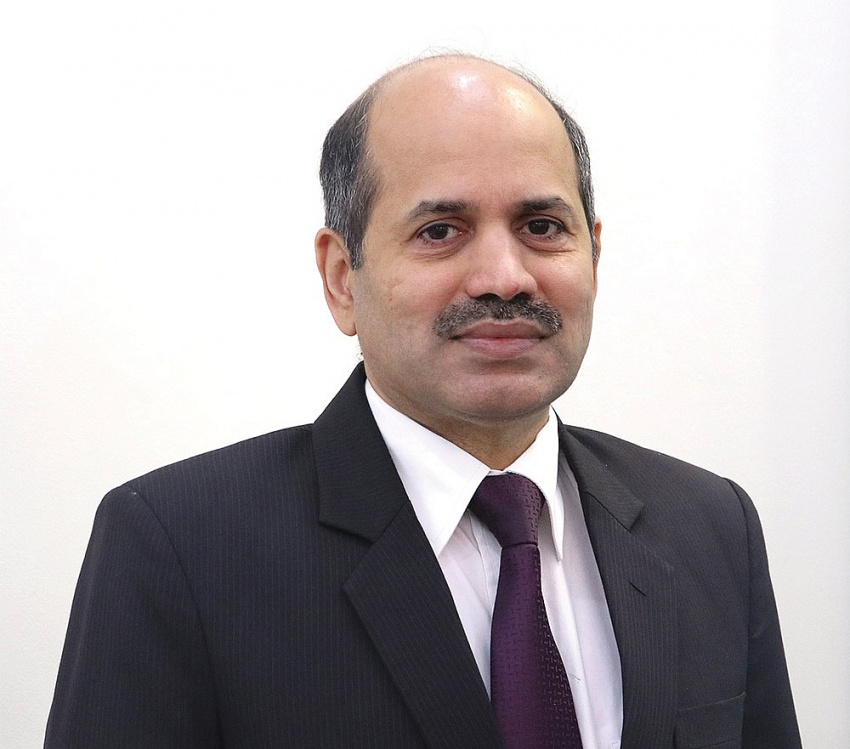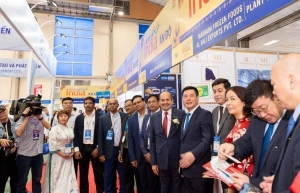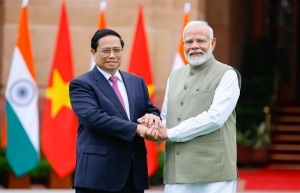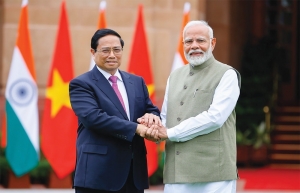India-Vietnam march together in progress
The International Monetary Fund has observed that India is contributing about 15 per cent of global growth, while Vietnam is widely recognised for its steady economic growth and integration with the world. Both countries have set high targets: India aims to be a developed country by 2047, while Vietnam aspires to become a high-income, developed country by 2045. These goals are backed by determined governments, dynamic entrepreneurs, and ambitious citizens in both nations.
 |
| Sandeep Arya, Indian Ambassador to Vietnam |
These national trends and directions are attracting growing attention from authorities and businesses in India and Vietnam, leading to vibrant efforts to capitalise on opportunities and synergies between them. This was evident at a joint ministerial commission on economic, trade, and sci-tech cooperation in October 2023 in Hanoi, the participation of Vietnam’s deputy prime minister at the Vibrant Gujarat Global Summit in January 2024 in India, and numerous other ongoing business-to-business engagements.
Economic growth and development in both nations are driven by strong infrastructural efforts, expanding power generation and distribution projects, the use of renewable energy, forward-looking industrialisation, foreign trade, investment plans, emerging technologies, innovation and startups, and supportive human resources and skills. These domains also guide efforts to strengthen economic relations between both nations.
The current bilateral trade volume of around $15 billion per year has significant growth potential, particularly for Indian exports in areas such as engineering goods (especially vehicle components), power equipment, pharmaceuticals, chemicals, agricultural products, textiles, ICT and other services, refined petroleum products, jewellery, and electronics. While Vietnamese trade experts are better positioned to judge, data suggests that Vietnam’s growing exports to India are competitive and could expand in areas such as mobile phones and accessories, electronic items and parts, machinery and equipment, and other industrial goods.
The ongoing review of the ASEAN-India Trade in Goods Agreement of 2009, set to be completed in 2025, should result in a more user-friendly, simplified, and trade-facilitative regime with Vietnam and other ASEAN countries. Both governments are also addressing technical issues in certain areas to facilitate and enhance trade between India and Vietnam. Mutual recognition of each other’s standards for manufactured goods would be mutually beneficial.
Sectoral discussions between the two governments in areas such as agriculture, healthcare, digital applications, energy, defence, and banking agree to also promote trade and economic ties. Connectivity, logistics, and transport have been identified as areas for further cooperation. The two countries will develop a framework for cross-border real-time digital payments that will benefit businesses, travellers, and residents.
Beyond government-level efforts, increased business-to-business contacts, participation in trade expos, collaboration on projects, supply chain links, and promotional initiatives will contribute to higher trade between the two countries.
Meanwhile, opportunities for greater investment between India and Vietnam are on the rise, with increasing interest among businesses from both sides. Indian investors in Vietnam are expanding their presence in vehicle components, food processing, consumer goods, energy, miscellaneous manufacturing, and IT services, and new sectors are being actively pursued. Prime Minister Pham Minh Chinh’s direct engagement with Indian businesses at the bilateral business forum in Delhi in July, and meetings with leaders of many Indian corporations, have been particularly encouraging.
Earlier this year, VinFast announced investments in e-vehicle production in India, while FPT is also expanding its presence there. Further investments from Vietnam are encouraged in agriculture, agro-processing, aquaculture, wood processing, urban development and infrastructure, production of bamboo and forestry products, hospitality and tourism, digital technology, e-vehicles, healthcare, and services.
Investment flows involve informing firms about opportunities, understanding the legal and business environment, discussions between enterprises and host governments, and business-to-business partnerships. Efforts are underway at all these levels, involving many firms in both nations, and it is hoped that the current investment value of $2 billion will grow in the coming years.
High technology and emerging fields will play an increasingly important role in future economies. Beyond digital applications, areas of interest for cooperation between India and Vietnam include telecommunications, fintech, semiconductors, AI, biotechnology, defence industries, the use of space and satellite data, and rare earths. Both sides intend to pursue these future-oriented areas with greater focus.
Human resource development is another priority. Indian institutions such as CDAC and Aptech have made significant contributions in Vietnam in this area, and plans by these and other ICT enterprises and technical training institutions to expand further in Vietnam appear promising. The recently established Centre of Excellence for Software Development and Training at the Post and Telecommunications Institute of Technology in Ho Chi Minh City will further support education, training, and skill development.
The Indian government’s scholarships for educational degree and short-term training programmes for over 200 Vietnamese students and experts each year could also be utilised to better meet Vietnamese priorities and interests.
Finally, tourism is a fast-growing area between India and Vietnam. Last year saw healthy growth in two-way travel involving tourists, pilgrims, businesses, students, and others. Travel operators in both countries are developing new travel packages for tourists, covering new destinations. Direct flights have played an important role, and further discussions are planned to expand these connections.
National trends and directions are attracting growing attention in India and Vietnam. The prospects and opportunities for stronger trade, investments, business partnerships, and technological collaboration between India and Vietnam are and will continue to be bright. We hope that efforts at the level of governments, businesses, and organisations to seize these opportunities will result in a higher level of comprehensive strategic partnership between the two countries.
 | India engages in expo in Vietnam to increase trade ties India has been welcomed as the guest of honour country at the 33rd Vietnam International Trade Fair (Vietnam Expo 2024) organised by Vietnam’s Ministry of Industry and Trade from April 3-6 in Hanoi. |
 | Vietnam, India issue joint statement Vietnam and India issued a Joint Statement on Strengthening of the Comprehensive Strategic Partnership between Vietnam and India on the occasion of Prime Minister Pham Minh Chinh’s State visit to India from July 30-August 1. |
 | Vietnam, India economic cooperation to thrive following strengthening of strategic partnership Leaders of India and Vietnam have agreed to reinforce cooperation among their governments and businesses to boost two-way trade, investment, and their technological partnership. |
 | India and Vietnam pledge to boost trade Vietnam and India are poised to strengthen their bilateral ties in new sectors, including trade and investment, with the support of an upgraded trade deal between the two economies. |
What the stars mean:
★ Poor ★ ★ Promising ★★★ Good ★★★★ Very good ★★★★★ Exceptional
Related Contents
Latest News
More News
- GE Vernova powers up Vietnam with first 9HA gas power plant in the country (January 06, 2026 | 16:54)
- Solid finish for manufacturing after volatile year (January 06, 2026 | 08:50)
- Meiko strengthens Vietnam operations with new PCB plants (January 06, 2026 | 08:49)
- Ho Chi Minh City backs $2 billion AI data centre with dedicated task force (January 06, 2026 | 08:43)
- PM sets January deadline for high-speed rail consultant (January 06, 2026 | 08:40)
- New decree spurs on PPP implementation (December 31, 2025 | 19:01)
- Global alliance develops $1 billion AI data centre network in Vietnam (December 30, 2025 | 10:08)
- Standing out in the Chinese outbound investment wave (December 29, 2025 | 10:29)
- Bright spots obvious in foreign investment mission (December 29, 2025 | 09:00)
- Ho Chi Minh City hits $8.37 billion in FDI (December 29, 2025 | 08:28)

 Tag:
Tag:

















 Mobile Version
Mobile Version